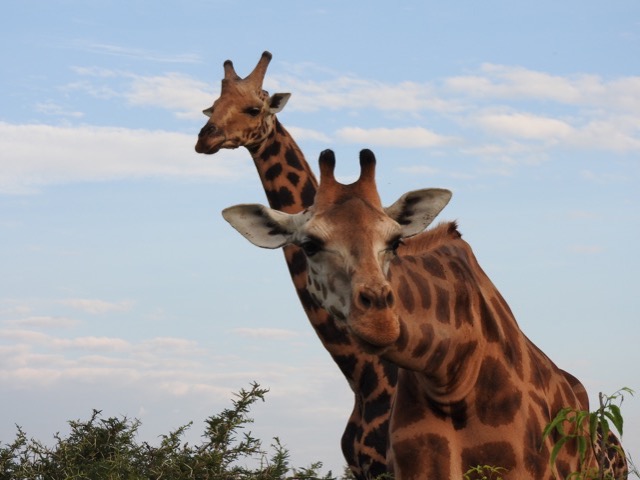
Travellers on safaris in Rwanda can combine a wildlife safari in Akagera National park with a gorilla trekking safari in Volcanoes National park and Chimpanzee trekking in Nyungwe National Park.
The park is home to Sitatunga, Shoebill Stork, elephant, buffalo, topi, zebra, waterbuck, roan antelope and eland. Other antelopes include duiker, oribi, bohor reedbuck, klipspringer, bushbuck and impala. It is also a home to a number of primates such as olive baboons, vervet monkeys, bush babies seen on night game drives, and the shy blue monkey.
Predators in the park such as leopard, hyena, side-striped jackal and the lion which was re-introduced to the park.
For the bird watching travellers, there are about 500 bird species that can be seen from this park; the shoebill is one of them, then the papyrus gonolek and countless other water birds that inhabit the wetlands.
Akagera National park can be explored on game drives with a driver guide. One can go for half day or full day games from the Northern to the Southern part of the this cool national park. If you choose to go for a self-drive in the park, make sure to hire a guide. You must hire one and make sure you have a 4 x 4 WD safari vehicle. You do not need to hire the guide before you visit the park. There are always available.
Experience a classic African Safari in beautiful Akagera National Park. With Lake Ihema in the background and cooler temperatures, this is a safari experience unlike any of Rwanda’s neighbours. A 7 seat 4 x 4 WD with open sides is also available for hire. All this information can be got from the information centre. But we can also assist you.
If staying over in the park, go for a guided nocturnal game drive which is very exciting. There are quite many animals which come out only at night and cannot be seen on day game drives. Other animals are more active in the night than the day and these include leopards, civets, hyenas, and bush babies which are seen easily at night
Nocturnal birds such as owls and night jars can only be seen in the night
Boat Safaris in Akagera National park are very exciting and take place on Lake Ihema. Scheduled and can be booked upon arrival or before through emailing us before hand.
Boat safaris are one of the highlight safaris in East Africa and Lake Ihema has the largest number of crocodiles. Look out for crocodiles too that you normally find basking at the shores of the lakes.
There are so many water birds that can also be sighted on this boat safari and one of these birds is the shoebill stork.
Animals like elephants come to the lake to drink water. This is a great way to watch them up close.
Let us know if you are interested in a boat safari in Akagera National park.
Akagera National park is a great birding destination with over 750 bird species found here and surely cannot be seen in one day. It is the birder’s watcher’s dream place to see the popular shoebill stork. Other birds to look out for include raptors, papyrus gonolek, migrant birds such as the lesser kestrel and the great sniper, the Zambian arnot chat, suaza shrike and the long tailed cistola, and many other birds like White-headed, Black and familiar Chats, Carruther’s and Tabora Cisticolas, White-winged and Broad-tailed Warblers and Miombo Wren-Warblers.
Sport fishing in Akagera National Park is done on Lake Shakani. This can be combined with a game drive in the park or a boat safari on Lake Ihema. The method used for fishing here is catch and release although people can take the fish caught for a meal.
It is also possible for anglers to participate in a fishing tournament that takes place here.
All sport fishing activities are booked through the national park offices.
Nature walks in this beautiful national park give you an opportunity to get up close and personal with nature. You will see and learn about different bird and butterfly species which you may not see well in a car on a game drive. Nature walks here are a peaceful way to take in and appreciate nature at a close space.
There is so much that takes place behind the scenes that a typical tourist may not know. Take part in the behind the scenes and learn more about the management of the park, law enforcement, how animals are collared and monitored by GPS, meet the staff of the park and hear about the day to day activities, meet the canine unit, meet the crowned crane conservation officers and other initiatives of the park. Meanwhile, Learn about the efforts the management of the park are putting in to get surrounding communities get involved in the conservation of the park. Let us know if you are interested in this experience
Akagera National Park is fenced and the fence line is walked everyday by fence attendants. With this activity, you will walk with them for a small part of 120km fence. The role of the fence is for conservation purposes. With a freelance guide from the surrounding community, you will take a 7km walk which takes about 2 hours depending on your pace. The walk is moderate to difficult. The walk starts from the entrance of the park, you then gently slope, meeting lots of singing birds and cattle herd’s men and farmers a long the way ready for the day’s activities. The fence goes up to the top of a hill along the ridge which offer beautiful views. There is also a stone fence known as the buffalo wall which was built to stop buffalos from crossing to people’s farms
Cultural tours which show the daily lives of the people especially in Eastern Rwanda who are cattle keepers. You will learn how to milk long horned cows with your hands, how cow dung is used and the different art in the area.
You can also visit Kageyo village and see the different milk pots used in storing milk, drink warm milk from a traditional gourd and learn different rituals that surround milk.
On a lucky day, you will be able to visit a market where cows are being auctioned. This takes place once a month.
In this village, you will also get a chance to see local women weaving beautiful baskets.
You have an opportunity to visit a local workshop where local artisans make traditional imigongo art which can be used for decorations. Furthermore, you will learn are these are made and what they mean in Rwandan art. The imigongo have got black and white contrasts. You will try to make yours with your own hands.
You will also visit a blacksmith who learned this skill from generations back and who will pass on this skill to the next generation in his family, They use metal scraps to make traditional garden hoes, repair pots and so on. This activity will be wrapped up with a cultural dance. Of course you will participate and learn how to drum and dance like local Rwandese
Visit Akagera National Park visitors centre museum and lean about its animals and dark past.
The museum has skulls of elephants, crocodiles and bones from other different animals that used to live in the park.
It also has different traps used by poachers and has information on what the park is doing to overcome this problem over the years.
This lodge was designed and built by the Akagera management company. It was opened in 2013 and has since been offering great accommodation for tourists visiting Akagera National park. An eco-friendly tented camp with only 20 beds. Located at the shores of Lake Ihema and is decorated with African décor.
Akagera Game Lodge was the only lodge in Akagera National park for a long time. Has comfortable rooms which tastefully furnished. It also has a restaurant, swimming pool, curio bar, tennis court, power supply, Wifi and a TV.
It is located inside the park which makes it very convenient to enjoy game drives
Karenge Bush Camp is a seasonal camp which started in 2016. The camp is set up two times a year and removed out, and leaving no trace of its being. Named Karenge which means a small foot in Rwandese because its aim is to leave a light foot print on earth. Built with eco friendly materials which are all removed at the end of each season when the camp decomposes. It is a small camp with only 6 tents which can sleep only 12 people
Camping is perfect for the adventurous traveller. You will spend a night under the stars at the sounds of the bush.
Akagera National park has three campsites namely Muyumbu which is north of the park entrance. It is on a high ridge overlooking Lake Ihema and the hills of Tanzania at a distance and offers a beautiful sunrise early in the morning.
The second campsite is called Shakani located near a lake side. From this campsite, you will hear hippos and calls from different birds.
The third campsite is Mutumba which is located in the north characterised by game and rolling grassland hills. It is also the highest point of the park at 1,800 meters above sea level. It has basic facilities that include a small open rondavel shelter, firewood, stone BBQs and pit latrines. Two sites are fenced. No power and no running water is available and the sites are not staffed.
6-man canvas tents can be hired from the park (for Muyumbu and Shakani only) but all other equipment and supplies should be brought with you.
The main entry into Rwanda is by Kigali international port. There are different airlines that fly into Kigali.
From Kigali, the park can be accessed by road which is about 2 hours on a good road. However, in the park strictly you need 4 x 4 WD vehicles. Thus we use 4 x 4 WD safari vehicles for all our clients.
Helicopter flights to the park are also available for travellers who dread road transport.
The best time to visit Akagera National Park is during the dry season from June to September. This is the time when there is rain and offers some of the best wildlife spotting opportunities.
Game drive safaris in Akagera are not as nice during the rainy months
